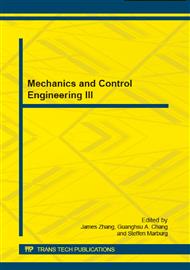[1]
Leonhard, W. Control of Electrical Drives, Springer-Verlag, third edition, (2001).
Google Scholar
[2]
R. Pena, J.C. Clare, and G. M. Asher, Doubly fed induction generator using back-to-back PWM converters and its application to variable speed wind-energy generation, IEE Proc. Electr. Power Appl., Vol. 143, No. 3, May 1996, pp.231-241.
DOI: 10.1049/ip-epa:19960288
Google Scholar
[3]
Cardenas, R.; Pena, R.; Alepuz, S.; Asher, G., Overview of Control Systems for the Operation of DFIGs in Wind Energy Applications, Industrial Electronics, IEEE Transactions on , vol. 60, no. 7, pp.2776-2798, July (2013).
DOI: 10.1109/tie.2013.2243372
Google Scholar
[4]
Xiangwu Yan; Venkataramanan, G.; Flannery, P.S.; Yang Wang, Evaluation the effect of voltage sags due to grid balance and unbalance faults on DFIG wind turbines, " Sustainable Power Generation and Supply, 2009 SUPERGEN , 09 International Conference on, vol., no., pp.1-10, 6-7 April (2009).
DOI: 10.1109/supergen.2009.5348141
Google Scholar
[5]
Rolán, A.; Córcoles, F.; Pedra, J., Doubly Fed Induction Generator Subject to Symmetrical Voltage Sags, Energy Conversion, IEEE Transactions on, vol. 26, no. 4, pp.1219-1229, Dec. (2011).
DOI: 10.1109/tec.2011.2160397
Google Scholar
[6]
Erlich, I.; Wrede, H.; Feltes, C., Dynamic Behavior of DFIG-Based Wind Turbines during Grid Faults, " Power Conversion Conference - Nagoya, 2007, PCC , 07, Vol., no., pp.1195-1200, 2-5 April (2007).
DOI: 10.1109/pccon.2007.373117
Google Scholar
[7]
Ling Peng; Francois, B.; Yongdong Li, Improved Crowbar Control Strategy of DFIG Based Wind Turbines for Grid Fault Ride-Through, Applied Power Electronics Conference and Exposition, 2009, APEC 2009, Twenty-Fourth Annual IEEE, Vol., no., pp.1932-1938, 15-19 Feb. (2009).
DOI: 10.1109/apec.2009.4802937
Google Scholar
[8]
Yuan Ren; Wei Zhang, A novel control strategy of an active crowbar for DFIG-based wind turbine during grid faults, Electric Machines & Drives Conference (IEMDC), 2011 IEEE International , Vol., no., pp.1137-1142, 15-18 May (2011).
DOI: 10.1109/iemdc.2011.5994761
Google Scholar
[9]
Lu Zhang; Xinmin Jin; Liangyu Zhan, A Novel LVRT Control Strategy of DFIG Based Rotor Active Crowbar, Power and Energy Engineering Conference (APPEEC), 2011 Asia-Pacific , Vol., no., pp.1-6, 25-28 March (2011).
DOI: 10.1109/appeec.2011.5749053
Google Scholar
[10]
Sun Li-ling; Yang Pu; Wang Yi, Simulation research for LVRT of DFIG based on rotor active crowbar protection, Sustainable Power Generation and Supply (SUPERGEN 2012), International Conference on, Vol., no., pp.1-7, 8-9 Sept. (2012).
DOI: 10.1049/cp.2012.1810
Google Scholar
[11]
Zhan Xu; Zaiping Pan, Influence of different flexible drive train models on the transient responses of DFIG wind turbine, Electrical Machines and Systems (ICEMS), 2011 International Conference on, Vol., no., pp.1-6, 20-23 Aug. (2011).
DOI: 10.1109/icems.2011.6073463
Google Scholar
[12]
Jemli, K.; Touaiti, B.; Jemli, M., Influence of the blades and the shaft rigidity of a wind turbine on the stability of the system under voltage dips, Electrotechnical Conference (MELECON), 2012 16th IEEE Mediterranean, Vol., no., pp.300-305, 25-28 March (2012).
DOI: 10.1109/melcon.2012.6196437
Google Scholar
[13]
Ren-jie Ye; Hui Li; Zhe Chen; Qiang Gao, Comparison of transient behaviors of wind turbines with DFIG considering the shaft flexible models, , Electrical Machines and Systems, 2008. ICEMS 2008. International Conference on, Vol., no., pp.2585-2590, 17-20 Oct. (2008).
Google Scholar
[14]
Foster, S.; Lie Xu; Fox, B., Behaviour and protection of doubly-fed induction generators during network faults, " Power & Energy Society General Meeting, 2009. PES , 09 IEEE, Vol., no., pp.1-8, 26-30 July (2009).
DOI: 10.1109/pes.2009.5275555
Google Scholar


